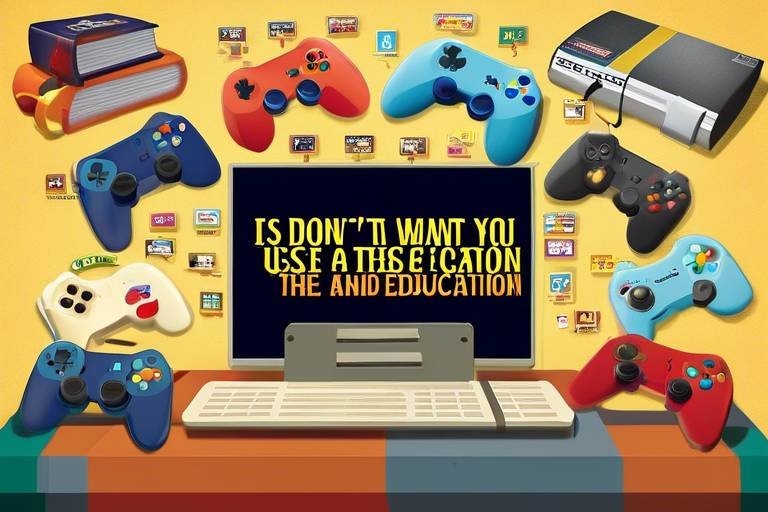Video Games in Education: The Pros and Cons
In today's digital age, the incorporation of video games into educational settings is a hot topic. With technology becoming an integral part of our lives, educators are exploring the potential of games not just for entertainment but as powerful learning tools. Imagine a classroom where students are not just passive recipients of information but active participants in their learning journey! Video games can offer a unique avenue for engagement, motivation, and critical thinking. However, like any tool, they come with their own set of challenges. This article delves into both the advantages and disadvantages of using video games in education, examining their impact on learning, engagement, and social skills development.
One of the most compelling arguments for using video games in education is their ability to enhance student engagement. Unlike traditional teaching methods, which can sometimes feel monotonous, video games can make learning feel like an adventure. They capture students' attention and can motivate them to explore new concepts in a fun and interactive way. When students are engaged, they are more likely to retain information and develop a genuine interest in the subject matter. For instance, games that require problem-solving or critical thinking can encourage students to think outside the box and develop their analytical skills.
Moreover, video games can foster a sense of community and collaboration. Many educational games are designed to be played in groups, promoting teamwork and communication among students. This collaborative aspect can help students develop essential social skills, as they learn to work together towards a common goal. In a world where teamwork is increasingly important, these skills can be invaluable in both academic and professional settings.
While the benefits of video games in education are noteworthy, it's crucial to consider the challenges and concerns that come with their use. One of the most significant issues is the potential impact on attention spans. With the fast-paced nature of many games, students may find it challenging to focus on traditional learning methods. This can lead to a cycle where students become accustomed to instant gratification from gaming, making it harder for them to engage with less stimulating tasks.
Research suggests that excessive gaming can lead to shorter attention spans in students. Studies have shown that while some games can enhance focus and concentration, others may contribute to a decline in these essential skills. For instance, a study conducted by the American Psychological Association found that students who spent more time playing action games showed improved visual attention but struggled with sustained attention on non-gaming tasks. This duality raises important questions about how we can effectively balance gaming with traditional educational methods.
Mixed results from various studies indicate that the relationship between gaming and attention spans is complex. Some research highlights the cognitive benefits of gaming, while others point to negative consequences. It is essential for educators to stay informed about these findings and consider them when integrating video games into their teaching strategies. For example, a study published in the Journal of Educational Psychology found that students who played educational video games showed improved problem-solving skills, but their ability to focus on lectures decreased.
To address attention span issues, educators can implement several strategies to create a balanced learning environment. Here are a few effective approaches:
- Integrate Breaks: Encourage regular breaks during gaming sessions to help students reset their focus.
- Mix Methods: Combine gaming with traditional teaching methods to provide a well-rounded educational experience.
- Set Limits: Establish guidelines for gaming time to prevent excessive use and maintain engagement in other activities.
Video games can indeed foster social interaction among peers, but they also present challenges in terms of face-to-face communication. While online multiplayer games allow students to connect with others, they may inadvertently discourage in-person conversations. This dual nature of gaming presents a unique challenge for educators. On one hand, students can develop teamwork and leadership skills through collaborative gameplay; on the other hand, they may struggle with social cues and interpersonal skills in real-world scenarios.
Successfully incorporating video games into the curriculum requires careful planning and alignment with educational goals. Educators must consider how games can enhance learning objectives and engage students effectively. The key lies in selecting the right games that align with the curriculum and provide meaningful learning experiences.
When it comes to selecting educational games, it's crucial to choose those that are not only entertaining but also align with learning objectives. Here are some guidelines:
- Look for games that promote critical thinking and problem-solving.
- Ensure the game content is age-appropriate and relevant to the curriculum.
- Consider games that encourage collaboration and teamwork among students.
Evaluating the effectiveness of video games in education is essential for understanding their impact on student learning outcomes. Educators can employ various methods to assess how gaming experiences contribute to knowledge retention and skill development. Regular feedback and assessments can help gauge students' progress and inform future teaching strategies.
Q: Can video games really help improve academic performance?
A: Yes, when integrated thoughtfully, video games can enhance engagement and motivation, leading to improved academic outcomes.
Q: What are the risks of using video games in education?
A: Potential risks include reduced attention spans and decreased face-to-face social interaction among students.
Q: How can educators balance gaming with traditional learning?
A: Educators can mix gaming with traditional methods, set time limits, and incorporate regular breaks to maintain balance.

The Benefits of Video Games in Learning
Video games have long been viewed as mere entertainment, but they have emerged as powerful tools in the realm of education. Imagine a classroom where students are not just passive recipients of information but active participants in their learning journey. This transformation is made possible through the integration of video games into educational settings. One of the most significant benefits of using video games in learning is their ability to enhance engagement. Traditional teaching methods can sometimes lead to disengagement, but video games captivate students' attention, making learning feel like an exciting adventure rather than a chore.
Moreover, video games promote motivation. When students play games, they often enter a state of flow, where they are fully immersed in the activity. This state can lead to increased motivation to learn, as students are more likely to tackle challenging concepts when they are presented in a fun and interactive format. For instance, games that incorporate problem-solving elements encourage critical thinking, allowing students to explore various strategies and solutions. This hands-on approach to learning can lead to improved educational outcomes.
In addition to engagement and motivation, video games can also foster critical thinking skills. Many educational games require players to analyze situations, make decisions, and adapt their strategies based on feedback. This process mirrors real-life problem-solving scenarios, equipping students with valuable skills that extend beyond the classroom. For example, games like Portal challenge players to think critically and creatively to navigate complex puzzles, reinforcing the importance of logical reasoning and spatial awareness.
Furthermore, video games can be particularly effective in catering to differentiated learning styles. Each student learns differently, and video games can accommodate various learning preferences. Visual learners benefit from vibrant graphics and animations, auditory learners engage with sound effects and voiceovers, while kinesthetic learners can interact physically with the game environment. This diversity allows educators to reach a broader range of students, ensuring that everyone has the opportunity to thrive.
To illustrate the impact of video games on learning, consider the following table showcasing key benefits:
| Benefit | Description |
|---|---|
| Engagement | Captivates students' attention and makes learning interactive. |
| Motivation | Encourages students to tackle challenges through immersive gameplay. |
| Critical Thinking | Enhances problem-solving skills by requiring analysis and strategy. |
| Differentiated Learning | Cater to various learning styles, promoting inclusivity. |
In conclusion, the incorporation of video games in education presents a myriad of benefits that can significantly enhance the learning experience. By fostering engagement, motivation, critical thinking, and accommodating diverse learning styles, video games have the potential to transform traditional educational paradigms. As we embrace this innovative approach, the future of learning looks more dynamic and interactive than ever before.

Challenges and Concerns
While the integration of video games into educational settings can yield numerous benefits, it is essential to address the that accompany this trend. One of the most pressing issues is the potential impact on students' attention spans. In a world where instant gratification reigns supreme, the fast-paced nature of video games can inadvertently lead to shorter attention spans in students. This phenomenon raises a critical question: Are we inadvertently training our brains to seek constant stimulation at the expense of deep, focused learning?
Research has shown that excessive gaming can result in a diminished ability to concentrate on tasks that require sustained attention. A study conducted by the American Psychological Association found that students who engage in prolonged gaming sessions may struggle to maintain focus during traditional classroom activities. This shift in attention can hinder academic performance, as students may find it challenging to engage with complex subjects that require critical thinking and prolonged concentration.
To delve deeper into this concern, it is crucial to examine the research findings on the relationship between gaming and attention span. While some studies suggest that video games can enhance cognitive skills, others indicate a troubling trend: a significant portion of students report difficulties in maintaining attention during lectures or reading assignments. This duality presents a paradox for educators and parents alike.
Key research highlights the mixed effects of gaming on students' ability to concentrate. For instance, a meta-analysis published in the journal Psychological Bulletin revealed that while action games can improve certain aspects of visual attention, they may also contribute to a decline in the ability to focus on non-gaming tasks. It’s a classic case of double-edged sword: while gaming can provide cognitive benefits, it may come at the cost of diminishing attention spans in traditional learning environments.
To counteract the potential negative effects on attention span, educators must implement strategies for mitigation. Balancing gaming with traditional learning methods is essential for creating a well-rounded educational experience. Some effective approaches include:
- Incorporating short gaming sessions as a reward for completing traditional assignments.
- Using games that require problem-solving and critical thinking to reinforce classroom concepts.
- Encouraging breaks between gaming sessions to allow students to reset their focus.
By integrating these strategies, educators can help ensure that video games serve as a tool for engagement rather than a source of distraction. However, the concern doesn't end with attention spans; another significant aspect to consider is the impact of gaming on social skills development.
Video games can foster social interaction among peers, providing opportunities for teamwork and collaboration in a virtual environment. However, there is a flip side—excessive gaming can hinder face-to-face communication. Many students may find themselves more comfortable interacting with avatars on a screen than engaging in real-life conversations. This shift raises an important question: Are we sacrificing genuine social interactions for the sake of virtual camaraderie?
In summary, while video games offer exciting possibilities for enhancing educational experiences, they also present significant challenges that need to be carefully navigated. By understanding the potential drawbacks and implementing effective strategies, educators can harness the power of gaming while minimizing its negative impacts.
Q: Can video games really help improve learning outcomes?
A: Yes, video games can enhance learning by promoting engagement and critical thinking skills. However, their effectiveness largely depends on how they are integrated into the educational curriculum.
Q: What are the primary concerns regarding video games in education?
A: The main concerns include potential negative impacts on attention spans, social skills development, and academic performance. These issues must be addressed for a balanced approach to gaming in education.
Q: How can educators mitigate the challenges associated with gaming?
A: Educators can mitigate challenges by balancing gaming with traditional learning methods, selecting appropriate games, and encouraging breaks to maintain focus and engagement.

Impact on Attention Span
The impact of video games on attention span is a hot topic of debate among educators, parents, and researchers alike. On one hand, video games can be incredibly engaging, pulling players into immersive worlds that demand their full attention. But on the other hand, there is a growing concern that excessive gaming might lead to shorter attention spans in students. Imagine a child who can focus intently on a fast-paced game for hours, yet struggles to pay attention during a 30-minute lesson in class. This dichotomy raises significant questions about how gaming affects our ability to concentrate.
Research findings on the relationship between gaming and attention span have been mixed. Some studies indicate that video games can help improve certain cognitive skills, such as hand-eye coordination and problem-solving abilities. For instance, action games often require players to make quick decisions and adapt to rapidly changing environments. However, these skills come at a cost. A study published in the journal Psychological Bulletin highlighted that while gamers may excel in tasks requiring quick reflexes, they often exhibit shorter attention spans when it comes to non-gaming activities.
Here are some key insights from recent research:
- Positive Effects: Certain types of video games, especially strategy and puzzle games, can enhance critical thinking and improve sustained attention in specific contexts.
- Negative Effects: Excessive exposure to fast-paced gaming can lead to difficulties in focusing on slower-paced tasks, such as reading or listening to lectures.
- Age Factor: Younger children may be more susceptible to attention span issues related to gaming than older teens or adults, who may have developed better self-regulation skills.
To address the potential drawbacks of gaming on attention spans, educators can adopt various strategies. For example, integrating short gaming sessions into traditional lesson plans can help maintain student engagement without overwhelming their attention. Additionally, setting clear boundaries around gaming time can encourage students to develop better focus during non-gaming activities. This balance is crucial in creating a well-rounded educational experience that leverages the benefits of gaming while mitigating its downsides.
Ultimately, the key is not to vilify video games but to understand their role in the broader context of education. By recognizing the potential impacts on attention spans, we can better equip ourselves to harness the positive aspects of gaming while addressing the challenges it presents. After all, education should be about finding the right tools to engage students, and video games can be one of those tools when used wisely.

Research Findings
When it comes to the impact of video games on attention spans, research findings present a mixed bag. Some studies suggest that video games can actually enhance certain cognitive skills, such as problem-solving and multitasking, which may lead to improved focus in specific contexts. For instance, a study conducted by researchers at the University of California found that students who played action games exhibited better spatial awareness and quicker decision-making abilities. However, the flip side of this coin is that excessive gaming can lead to shorter attention spans, making it challenging for students to concentrate on more traditional educational tasks.
One pivotal study published in the journal Psychological Bulletin highlighted that children who engage in prolonged gaming sessions often struggle with maintaining attention during classroom activities. This can be attributed to the fast-paced nature of video games, which may condition players to expect constant stimulation. As a result, when faced with the slower pace of traditional learning, these students may find it difficult to stay engaged. The researchers noted that while video games can be beneficial in moderation, they may inadvertently contribute to a decline in attention spans when not balanced with other forms of learning.
To illustrate these findings further, consider the following table summarizing key research outcomes on the relationship between gaming and attention spans:
| Study | Findings | Implications |
|---|---|---|
| University of California Study | Improved spatial awareness and decision-making | Gaming can enhance specific cognitive skills |
| Psychological Bulletin Study | Prolonged gaming linked to reduced attention in class | Need for balance between gaming and traditional learning |
| Journal of Educational Psychology | Mixed effects on academic performance | Varied outcomes based on game type and duration |
These findings underscore the importance of context when evaluating the effects of video games on attention spans. While some games may foster beneficial skills, others, especially those that are highly immersive and fast-paced, can lead to a decline in students' ability to concentrate. Therefore, it’s essential for educators and parents to monitor gaming habits and encourage a balanced approach to both gaming and learning.
In light of these research findings, it’s clear that video games hold both potential benefits and risks. The key lies in understanding how to harness the positive aspects while mitigating the negative effects. By doing so, we can create a more effective educational environment that leverages the engaging nature of video games without compromising students' attention spans.
- Can video games improve learning outcomes? Yes, when integrated thoughtfully, video games can enhance engagement and critical thinking skills.
- Do video games negatively affect attention spans? Research shows mixed results; while some games can improve focus, excessive gaming may lead to shorter attention spans.
- What types of video games are best for education? Educational games that align with learning objectives and encourage problem-solving are most effective.
- How can educators balance gaming with traditional learning? By implementing structured gaming sessions and combining them with conventional teaching methods.

Strategies for Mitigation
In a world where video games are becoming increasingly prevalent in education, it's essential to address the potential downsides associated with their use. One of the most pressing concerns is the impact of gaming on students' attention spans. To combat this issue, educators can adopt various strategies to ensure that video games serve as a beneficial tool rather than a distraction.
First and foremost, setting clear boundaries around gaming time is crucial. This can involve establishing specific periods during the school day dedicated to gaming, ensuring that it does not overshadow traditional learning methods. By creating a structured environment, students can enjoy the benefits of gaming while still engaging in focused learning activities. For example, educators might implement a schedule that alternates between gaming sessions and conventional lessons, allowing students to recharge their attention spans without overindulging in screen time.
Additionally, incorporating game-based learning into the curriculum can help maintain a balance. Educators can design lessons that integrate gaming elements while keeping the core educational objectives intact. This approach not only makes learning more engaging but also encourages students to apply critical thinking skills in a game context. For instance, a history lesson could involve a simulation game that requires students to strategize and make decisions based on historical events, thus reinforcing their understanding through interactive play.
Moreover, fostering a collaborative gaming environment can enhance social skills while mitigating attention span issues. Group gaming sessions can promote teamwork and communication among students, encouraging them to work together to solve problems or achieve common goals. This not only helps develop social skills but also allows students to learn from one another, creating a more dynamic and interactive learning experience. Teachers can facilitate discussions around the game's content, encouraging students to share their thoughts and strategies, which can further enhance their engagement and focus.
Lastly, regular assessments of both gaming and traditional learning outcomes are vital. By evaluating how well students are retaining information and staying engaged, educators can adjust their strategies accordingly. This can involve using quizzes, group discussions, or even reflective essays where students express their thoughts on the gaming experience and its relevance to their learning. Such evaluations not only provide insight into the effectiveness of gaming in education but also empower students to take ownership of their learning journey.
In conclusion, while video games have the potential to impact attention spans negatively, implementing structured strategies can help mitigate these effects. By balancing gaming with traditional learning, fostering collaboration, and regularly assessing outcomes, educators can create a well-rounded educational experience that harnesses the power of video games for positive learning outcomes.
- Can video games improve academic performance? Yes, when integrated thoughtfully into the curriculum, video games can enhance engagement and motivation, leading to improved academic outcomes.
- How can teachers choose the right games for their classrooms? Educators should select games that align with learning objectives and cater to the diverse needs of their students, ensuring that the content is educational and age-appropriate.
- What are some signs of excessive gaming in students? Signs may include decreased attention in class, neglecting homework, or prioritizing gaming over social interactions and physical activities.
- How can parents support their children's gaming habits? Parents can monitor gaming time, encourage educational games, and engage in discussions about what their children are learning through gaming experiences.

Social Skills Development
Video games have a fascinating duality when it comes to . On one hand, they can serve as a powerful tool for fostering social interaction among peers, while on the other hand, they may inadvertently hinder face-to-face communication. Imagine a group of friends gathering around a console, laughter echoing through the room as they embark on a virtual adventure together. This scenario illustrates how gaming can create a shared experience that encourages teamwork and collaboration. Players often engage in strategic discussions, share tips, and celebrate victories, all of which can enhance their social bonds.
However, it's essential to consider the flip side. Excessive gaming can lead to a decline in real-world interactions. As students become more engrossed in their screens, they might miss out on opportunities to develop crucial interpersonal skills. The art of conversation, the nuances of body language, and the subtleties of emotional intelligence may take a backseat to virtual achievements. For instance, a student who spends hours in front of a gaming console might find it challenging to engage in meaningful discussions with their peers in a classroom setting. This raises a pertinent question: are we trading valuable face-to-face interactions for virtual ones?
Research indicates that the impact of gaming on social skills is not black and white. Some studies suggest that multiplayer games can enhance communication skills and promote teamwork, while others warn about the risks of isolation. To better understand this dynamic, consider the following table:
| Aspect | Positive Effects | Negative Effects |
|---|---|---|
| Communication | Improved teamwork and strategic discussions | Reduced face-to-face interaction |
| Empathy | Increased understanding of diverse perspectives | Potential desensitization to real-world emotions |
| Conflict Resolution | Opportunities to navigate disagreements in-game | Difficulty resolving conflicts offline |
To harness the benefits of video games while mitigating their drawbacks, educators and parents can take proactive steps. Encouraging balanced gaming habits is crucial. Setting time limits on gaming sessions and promoting activities that require face-to-face interaction can help students develop a well-rounded social skill set. Additionally, integrating games that require collaboration and communication can enhance these skills in a fun and engaging way.
In conclusion, video games have the potential to be a double-edged sword in the realm of social skills development. They can either foster a sense of community and teamwork or lead to isolation and diminished interpersonal skills. By being mindful of how gaming is integrated into students' lives, we can ensure that they reap the benefits while avoiding the pitfalls. After all, the goal is to create well-rounded individuals who can thrive both in the digital world and in real-life social settings.
- Can video games improve social skills? Yes, many multiplayer games encourage teamwork and communication among players.
- What are the risks of excessive gaming? Excessive gaming can lead to isolation and hinder face-to-face communication skills.
- How can parents help their children balance gaming and real-life interactions? Setting time limits and encouraging participation in offline activities can help maintain this balance.

Integrating Video Games into Curriculum
Integrating video games into the curriculum is not just about throwing a console in the classroom and letting students have at it. No, it’s a carefully crafted process that requires thoughtful consideration and strategic planning. The key is to align the games with educational goals while ensuring that they enhance the overall learning experience. Think of it like adding spices to a dish; too much can ruin it, but just the right amount can elevate it to a whole new level.
First off, educators need to identify the specific learning objectives they want to achieve. Are they looking to improve problem-solving skills, enhance creativity, or perhaps boost collaboration among students? Once those goals are set, the next step is to choose the right games. Not all video games are created equal, and selecting games that align with these educational objectives is crucial. For instance, games that require strategic thinking can help improve analytical skills, while cooperative multiplayer games can foster teamwork.
To aid in this selection process, educators can utilize a game evaluation rubric. This rubric can assess various aspects of a game, such as educational value, engagement level, and suitability for the age group. Here’s a simple example of what such a rubric might look like:
| Criteria | Score (1-5) |
|---|---|
| Educational Value | |
| Engagement Level | |
| Age Appropriateness | |
| Technical Requirements |
Once the games are selected, it’s essential to develop a comprehensive plan for implementation. This plan should include how the games will be integrated into existing lesson plans, how much time will be allocated for gaming, and what outcomes are expected. For example, if a game is used to teach history, teachers might set aside one class period each week for students to play, followed by discussions that connect the game’s content to real historical events.
Additionally, incorporating video games into the curriculum also means preparing students for a different kind of assessment. Traditional tests might not effectively measure the skills gained through gaming. Therefore, educators should consider alternative assessment methods, such as project-based evaluations or reflective essays that allow students to articulate what they’ve learned. This approach not only encourages deeper understanding but also helps students develop critical thinking skills.
Finally, it’s vital to gather feedback from students regarding their gaming experiences. This feedback can provide invaluable insights into how well the games are meeting educational objectives and can inform future integration efforts. By creating an open dialogue about the gaming experience, educators can adjust their strategies to better meet the needs of their students.
In conclusion, integrating video games into the curriculum is a multifaceted endeavor that requires careful planning and execution. When done correctly, it can transform the educational landscape, making learning more engaging and effective for students. So, are you ready to take the plunge and explore the exciting world of educational gaming?
- What types of video games are best for educational purposes? Educational games that promote critical thinking, creativity, and collaboration are ideal. Look for games designed specifically for learning, or those that align with your curriculum goals.
- How can I assess student learning through video games? Consider using project-based assessments, reflective essays, or group discussions to evaluate what students have learned from their gaming experiences.
- Are there any age restrictions for educational video games? Yes, it’s important to choose games that are age-appropriate and suitable for the maturity level of your students to ensure a positive learning experience.

Choosing the Right Games
When it comes to integrating video games into the educational landscape, one of the most crucial steps is . Not all games are created equal, and selecting the right ones can significantly influence the learning experience. The ideal educational game should not only align with curriculum objectives but also resonate with students' interests and learning styles. So, how do you sift through the myriad of options available? Here are a few key factors to consider:
First and foremost, the educational value of the game is paramount. Look for games that promote critical thinking, problem-solving, and creativity. For instance, games that require players to strategize or collaborate can enhance cognitive skills while keeping students engaged. Additionally, consider the age appropriateness of the game. A game designed for younger audiences may not hold the same appeal for high school students. Therefore, it’s essential to match the game’s complexity and themes with the age group you are targeting.
Another vital aspect is the interactivity and engagement the game offers. Games that allow for active participation tend to keep students more engaged than passive ones. Look for titles that encourage collaboration among peers, as these can foster teamwork and communication skills. Furthermore, consider the feedback mechanisms integrated into the game. Games that provide immediate feedback can significantly enhance the learning process by allowing students to understand their mistakes and learn from them in real-time.
Moreover, it’s important to evaluate the technical requirements of the game. Ensure that the necessary technology is available in your classroom or learning environment. This includes checking for compatibility with devices, internet requirements, and whether the game can be easily integrated into existing lesson plans. A well-planned approach can prevent technical issues that might disrupt the learning process.
To summarize, here are some key points to keep in mind when choosing educational games:
- Educational Value: Ensure the game promotes critical thinking and creativity.
- Age Appropriateness: Match the game’s complexity with the target age group.
- Interactivity: Look for games that encourage active participation and collaboration.
- Feedback Mechanisms: Choose games that offer immediate feedback to enhance learning.
- Technical Requirements: Verify that the game is compatible with available technology in the classroom.
By carefully considering these factors, educators can select video games that not only engage students but also contribute to their learning objectives. The right game can transform a mundane lesson into an exciting adventure, making education both fun and effective. So, don’t just dive in—take the time to evaluate your options and choose wisely!

Assessment and Evaluation
When it comes to integrating video games into education, assessment and evaluation play a pivotal role in determining their effectiveness. It's not just about letting students play; it's about understanding how these games impact their learning outcomes. So, how do we measure the success of video games in educational settings? The answer lies in a combination of qualitative and quantitative methods.
First and foremost, educators need to establish clear learning objectives that align with the educational goals of the curriculum. This means identifying what skills or knowledge students are expected to gain from the gaming experience. For example, if a game is designed to teach math skills, the assessment should focus on how well students can solve problems after engaging with the game. By setting these benchmarks, teachers can create a framework for evaluating student progress.
One effective method for assessment is through formative assessments, which can be conducted during and after gameplay. These assessments might include quizzes, reflective journals, or class discussions that encourage students to articulate what they’ve learned. For instance, after playing a historical simulation game, a teacher might ask students to write a short essay on the historical events they encountered in the game. This not only reinforces learning but also helps educators gauge student understanding.
Additionally, data analytics can provide valuable insights into student performance. Many educational games come equipped with tracking systems that monitor progress and engagement levels. By analyzing this data, educators can identify trends and patterns, allowing them to tailor their teaching strategies accordingly. For example, if data shows that a group of students struggles with a particular concept, the teacher can adjust the curriculum to provide additional support.
However, it's essential to approach assessment with a balanced perspective. While quantitative data is crucial, qualitative feedback from students can offer a deeper understanding of their experiences. Engaging students in discussions about their gameplay can reveal their thought processes and emotional responses, which are just as important as test scores. This can be done through
- Surveys
- Focus groups
- One-on-one interviews
In conclusion, effective assessment and evaluation of video games in education require a multifaceted approach. By combining clear learning objectives, formative assessments, data analytics, and qualitative feedback, educators can gain a comprehensive understanding of how gaming impacts student learning. This holistic view not only enhances educational outcomes but also ensures that video games are used as a powerful tool for engagement and skill development.
Q: How can educators assess the effectiveness of video games in the classroom?
A: Educators can assess effectiveness through formative assessments, data analytics, and qualitative feedback from students. Establishing clear learning objectives is key.
Q: What types of assessments can be used with educational games?
A: Various assessments can include quizzes, reflective essays, class discussions, and data tracking from the games themselves.
Q: Are video games suitable for all subjects?
A: While video games can be beneficial in many subjects, it's essential to choose games that align with specific learning objectives to ensure they enhance educational outcomes.
Frequently Asked Questions
- What are the main benefits of using video games in education?
Video games can significantly enhance learning by boosting engagement and motivation. They also promote critical thinking skills as students navigate challenges and solve problems within the game. This interactive approach can lead to improved educational outcomes, making learning more enjoyable and effective.
- Are there any concerns regarding video games affecting attention spans?
Yes, there are concerns that excessive gaming may contribute to shorter attention spans among students. Some research indicates that while video games can improve focus in certain contexts, they may also lead to difficulties in maintaining concentration during traditional learning activities.
- How can educators mitigate attention span issues related to gaming?
Educators can implement strategies such as balancing video game use with conventional teaching methods, incorporating structured breaks, and setting clear time limits on gaming sessions to ensure that students remain engaged without losing focus on their studies.
- Can video games help develop social skills?
Absolutely! Video games can foster social interaction among peers, especially in multiplayer settings. However, it's important to note that they might also hinder face-to-face communication. Finding a balance between online and offline interactions is key to developing well-rounded social skills.
- What should educators consider when integrating video games into the curriculum?
When integrating video games, educators should carefully choose games that align with educational goals and student needs. It's also crucial to evaluate how these games can enhance learning and fit within existing lesson plans to ensure a cohesive educational experience.
- How can the effectiveness of video games in education be assessed?
The effectiveness can be assessed through various methods, including student feedback, performance metrics, and observational studies. These assessments help educators understand how gaming experiences impact student learning outcomes and engagement levels.



















